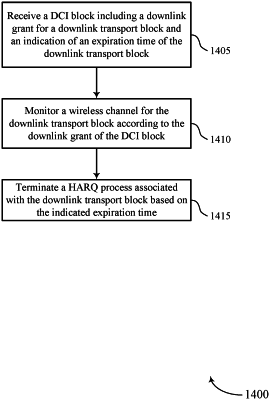| CPC H04W 72/23 (2023.01) [H04L 1/1819 (2013.01); H04L 5/0055 (2013.01); H04W 28/0278 (2013.01); H04W 72/20 (2023.01); H04W 72/569 (2023.01)] | 30 Claims |

|
1. A method for wireless communication by a user equipment (UE), comprising:
receiving a downlink control information (DCI) message comprising a downlink grant for a downlink transport block and an indication of an expiration time of the downlink transport block;
monitoring a wireless channel for the downlink transport block according to the downlink grant of the DCI message; and
terminating, based at least in part on a failure to successfully decode the downlink transport block prior to the expiration time, a hybrid automatic repeat request (HARQ) process associated with the downlink transport block by emptying a HARQ buffer corresponding to the downlink transport block.
|